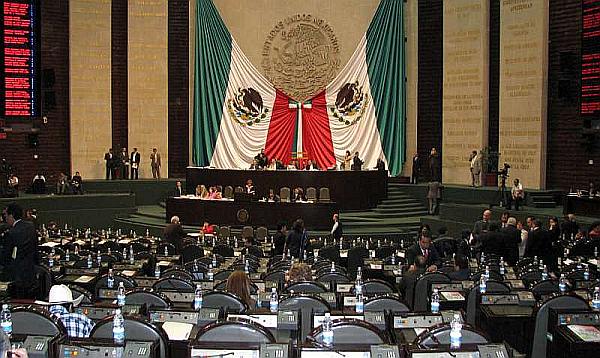Mexico City - On June 7, 2015, Mexico is scheduled to hold its mid-term congressional elections. Analysis of the Mexican Congress is important to any serious study of Mexican politics. The Mexican political system runs on a six-year schedule, in contrast to the U.S.A., which runs on a four-year cycle.
In the U.S. there are presidential elections every four years, the latest having been in 2012 and the next scheduled for 2016. At the halfway point between each presidential election, congressional mid-term elections are held, the last ones having been in 2014.
In Mexico, the president is elected every six years, the last election having been held in 2012 and the next one scheduled for 2018. Mexican mid-term congressional elections are thus held at the halfway-point between presidential elections, three years after the previous one and three years before the next one.
Thus 2015 is the year to hold mid-term elections, and they are scheduled for June 7th. In Mexico, elections are held on Sundays, whereas in the U.S. they are held on Tuesdays.
This mid-term can be considered a referendum on the administration of President Enrique Peña Nieto. Working with the current Congress, his administration has accomplished several reforms, (including the energy reform) but is under fire for its handling of the Iguala Atrocity and other issues.
There are ten Mexican political parties involved in the mid-term elections. They are:
1. Partido Revolucionario Institucional (Peña Nieto's party)
2. Partido Accion Nacional (Party of previous president, Calderon)
3. Partido de la Revolución Democrática (principal left-wing party)
4. Partido del Trabajo
5. Partido Verde Ecologista de México (Green Party)
6. Movimiento Ciudadano
7. Nueva Alianza
8. Movimiento Regeneración Nacional (MORENA, AMLO'S party)
9. Partido Humanista
10. Partido Encuentro Social
I invite the reader to read an article I previously wrote for another website about Mexican elections, entitled Elections in Mexico and the US: Comparisons and Contrasts.
Like the United States, Mexico has a two-chamber (bicameral) Congress. The upper chamber is the Senado, equivalent to the U.S. Senate. The lower chamber is the Cámara de Diputados, equivalent to the U.S. House of Representatives.
While the U.S. Congress has 100 senators and 435 representatives, the Mexican Congress is actually larger (in both chambers). There are 128 senadores in the Senado and 500 diputados in the Cámara de Diputados.
In the Cámara de Diputados, 300 of the 500 diputados are directly elected by their districts. The other 200, however, are selected by proportional representation, with seats allocated based on the percentage of votes received by the political party in the circunscripcion electoral in which the state is located. (Mexico is divided into five divisions, called circunscripciones electorales.)
In the Mexican Senado the selection process is even more complicated. Each of Mexico's 31 states, and the Federal District, sends 3 senators to the Congress.
Candidates from each political party run in pairs. The pair winning the most votes is elected to the Senado to represent that particular state. The state's other senador is from the political party that came in second in that state's senatorial election.
That accounts for 96 senators. The other 32 are selected by proportional representation, bringing it to a total of 128.
However, in 2015, there will be no senadores elected. Unlike the U.S., where senator's terms are staggered, with a third up for reelection each two years, in Mexico the entire Senate is elected the same year, and that was in 2012.
In the Mexican Congress, senators and representatives are barred from immediate reelection, though they can return for a later term and stand for reelection. Since the diputados have three-year terms and the senadores have six-year terms, that means the entire Cámara de Diputados is replaced every three years, and the entire Senado every six years. Thus the entire Congress is replaced every six years.
That, however is in the process of being changed. Constitutional changes passed in late 2013 and early 2014 make it possible for diputados and senadores to be reelected, to serve a maximum of twelve consecutive years (two terms for senadores and four terms for diputados).
That change doesn't come into effect for this election, however. So in 2015, nobody can yet be reelected. However they can be in 2018. So that means some of the diputados and senadores elected in 2015 may be the first to be reelected in 2018.
The new Cámara de Diputados elected this June is scheduled to take office September 1st. Allan Wall is an American citizen who moved back to the U.S. after living and teaching English in Mexico for a decade and a half. Today, he continues to write articles about various aspects of Mexico and Mexican society. Some of these articles are about Mexico's political scene, history and culture, tourism, and Mexican emigration as viewed from south of the border, which you can read on his website at AllanWall.info.
Allan Wall is an American citizen who moved back to the U.S. after living and teaching English in Mexico for a decade and a half. Today, he continues to write articles about various aspects of Mexico and Mexican society. Some of these articles are about Mexico's political scene, history and culture, tourism, and Mexican emigration as viewed from south of the border, which you can read on his website at AllanWall.info.


